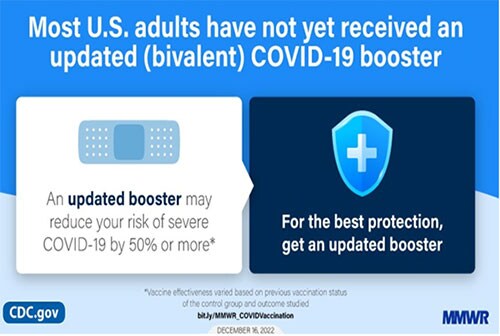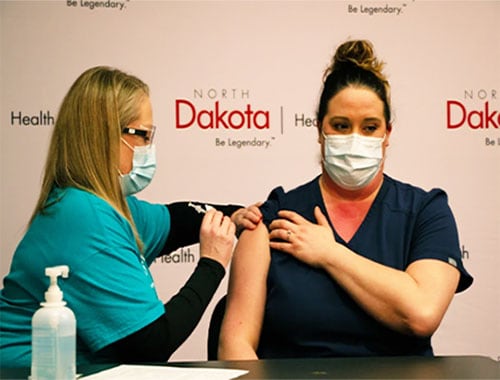North Dakota in the Spotlight for COVID-19 Vaccination Coverage in Long-Term Care Facilities
The COVID-19 pandemic continues to put tremendous pressure on the U.S. health care system, including long-term care facilities (LTCFs), which provide medical and personal care to people who are unable to live independently. Residents and staff of nursing homes and other LTCFs are disproportionately affected by COVID-19. According to the Kaiser Family Foundation’s latest numbers from September 2022, over 209,000 COVID-19 deaths, or just over every one in five COVID-19 deaths has been in a long-term care facility, including nursing homes. Most COVID-19 deaths occur in people older than 65, so it is important for LTCFs such as nursing homes to stay up to date with vaccinating residents and staff.
Providing the updated COVID-19 bivalent booster is a priority. The bivalent booster provides additional protection against COVID-19-associated emergency department/urgent care encounters and hospitalizations in persons who previously received 2 or more boosters. The bivalent boosters are formulated to better protect against more recently circulating COVID-19 variants and can help restore protection that has waned since previous vaccination.
North Dakota is making significant strides when it comes to getting LTCF residents vaccinated with the updated COVID-19 booster. The state is among the leaders in COVID-19 vaccination coverage in LTCFs. Jennifer Galbreath, Adult Vaccine Manager for North Dakota Health and Human Services (NDHHS), outlines some of their successful strategies:
- Immunization staff linked each LTCF with a primary and back-up vaccinator. These LTCFs were surveyed with each vaccine rollout (primary series, boosters) to make sure they still have a vaccinator.
- NDHHS contracted with North Dakota State University Center for Immunization Research and Education to conduct education at LTCFs regarding COVID-19 vaccination.
- LTCFs are surveyed weekly about their vaccination rates.
- NDHHS offered $5,000 to facilities for upgrading storage and handling equipment for COVID-19 vaccination.
- With each rollout, LTCFs and pharmacies were encouraged to vaccinate within two weeks of a recommendation being released.
The two-week period for LTCFs and pharmacies to complete vaccination created a realistic deadline and sense of urgency, Galbreath says “We just [put the two-week timeframe] out there – there’s no real reason other than we just knew we wanted the vaccinations to be done rapidly and they rose to the challenge.”
According to the U.S. Census Bureau’s 2020 population estimates, North Dakota has approximately 779,000 residents. Out of the 50 states and the District of Columbia, North Dakota ranks 47th in total population. Persons 65 years and older account for 16% of the population. That’s close to the national average of 16.5%.
Staying Vigilant
LTCFs in North Dakota were hit hard with COVID-19 cases, hospitalizations, and deaths early in the pandemic, which Galbreath said had a positive impact on vaccine acceptance. Despite an understanding of the risks of COVID-19 and benefits of vaccination, she says “keeping people engaged is one of the larger challenges. Being persistent in messaging is the key to keeping it [COVID-19 vaccination] relevant in people’s minds.”

The bivalent COVID-19 boosters have been available since September 2022. As of mid-December 2022, less than 50% of the country’s nursing home residents have received a COVID-19 bivalent booster compared to 69.7% among ND nursing homes. Galbreath says vaccine uptake is “slower than we would like to see,” adding, “the 65 and older population tends to show up for vaccinations generally overall, but they didn’t for the bivalent booster.” Galbreath says being persistent is important. “We’re offering extended education to the facilities and really offering to go in and help vaccinate – we’re still working hard.” For the state’s overall 65+ population, 42.6% have received the bivalent booster.
Galbraith is proud of North Dakota’s achievements, “I think our relationships overall with our long-term care facilities, or even some of our non-traditional vaccine partners, have probably been the biggest success. Before COVID, I could not have told you the last time I ever talked to a long-term care facility about vaccination – same with pharmacies. COVID has brought out the need to have a lot of providers be vaccinators.” As far as lessons learned, she believes tailoring education to LTCF personnel and assisting them with their needs are the most important steps moving forward.
Federal Government Makes Push for Bivalent Boosters in Nursing Homes

A nursing home staff member gets vaccinated in Mandan, North Dakota.
From a national perspective, nearly 161,000 nursing home residents have died from COVID-19 since 2020. Dr. Ashish Jha, the White House COVID-19 Response Team leader, says the federal government is working with nursing homes to increase uptake of the bivalent booster. As we enter the winter months with increasing cases of respiratory diseases, including COVID-19, there is a critical need to encourage older adults to receive the updated boosters, especially those living in long-term care settings (LTC). Older adults are at high risk for severe illness, hospitalization, and death from COVID-19.
CDC data on nursing homes indicates:
- COVID-19 case rates:
- Are higher in nursing home residents who have not received all recommended doses than those who are up to date.
- COVID-19 vaccination rates, as of December 25, 2022:
- 48% of nursing home residents in the United States are up to date with COVID-19 vaccination.
- 21% of nursing home staff in the United States are up to date with COVID-19 vaccination.
People who live or work in a long-term care setting can help protect themselves and others by staying up to date with COVID-19 vaccines, including boosters as soon as possible.
- COVID-19 vaccines are safe and effective—especially against becoming seriously ill, being hospitalized and dying—and are very important for older adults and those around them, including LTCF staff.
- Older adults and people with certain health conditions are more likely to get very sick from COVID-19.
- COVID-19 vaccines can help keep you from getting seriously ill if you do get COVID-19.
- Use the COVID-19 booster tool to learn when you can get an updated (bivalent) booster to stay up to date with all recommended COVID-19 vaccines.
What are you, your health department, or your organization doing to support COVID-19 vaccination in your community? Share your story with communityfeatures@cdc.gov and you could see it on our COVID-19 Vaccine Community Features page.